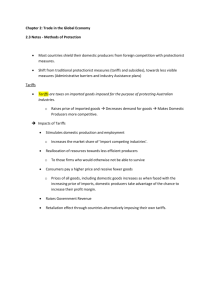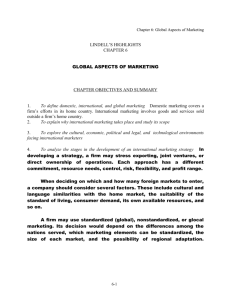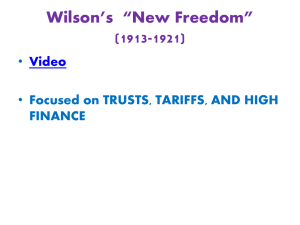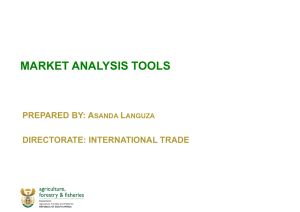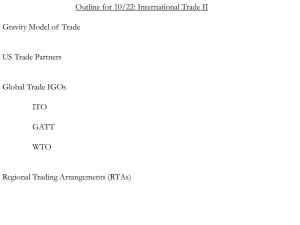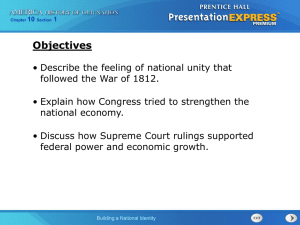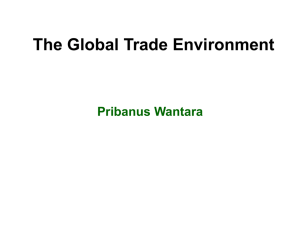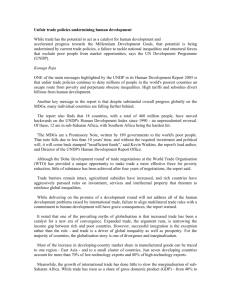The History of Agricultural Protectionism.
advertisement
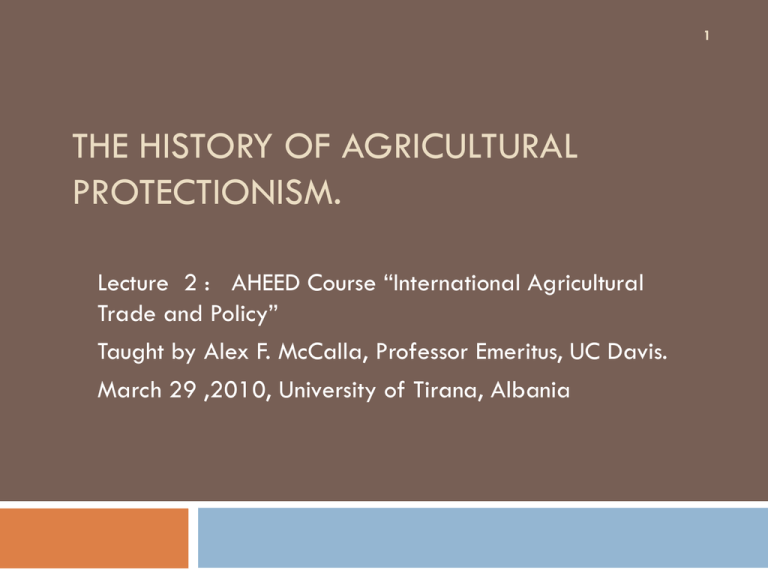
1 THE HISTORY OF AGRICULTURAL PROTECTIONISM. Lecture 2 : AHEED Course “International Agricultural Trade and Policy” Taught by Alex F. McCalla, Professor Emeritus, UC Davis. March 29 ,2010, University of Tirana, Albania Brief History of World Agricultural Protectionism. 2 Mercantilist Era – 16th to 18th century – encourage exports & discourage imports, esp. with tariffs & subsidies - European colonization Adam Smith (1723-1790) criticized Mercantilism Protectionism was common in Europe – e.g., the Corn Laws were taxes on British wheat imports, in effect from early 1800s to favor wealthy landowners. Thomas Malthus supported them (seems ironic); David Ricardo opposed them; Navigation Acts restricted shipping to British Bottoms British Parliament- A Revolution in Trade Policy. 3 1850: A New Beginning in Trade 4 The Bank Charter Act 1844- institutionalized the Gold Standard; The Corn Laws repealed 1846; Navigation Acts repealed 1849; These Changes committed Britain to a policy of free trade and marked the symbolic end of Mercantilism: Also beginnings of the Industrial Revolution; Rapid expansion of Ag. Production in newly settled areas –NA, Samer, Africa and Australia; Revolution in shipping-steam ship and railroads Look at in 3 periods: 1850-1914;1919-1939;Post WWII 1850-1914: The Golden Era of Free Trade 5 1.Trade: rapid & dramatic changes in volume, direction and composition of trade. value up 8X 1830-1878 and another 3X 1878-1914. Composition- from high valued per unit of weight specialty products-spices, precious metals to heavier lower value/unit products like wheat, sugar and manufactured products; Relative importance of primary products declined even though value tripled; by 1914 ag down to 30-40% of trade. 1850 -1914 cont. 6 2. Prices and policies: 1850-1875 general movement in Europe to reduce barriers, UK as hegemonic power pushed others along. Period of rising ag prices; UK- France Cobden-Chevalier Reciprocal Trade Agreement- 1st use of concept of “Most Favored Nation (MFN)” French repealed their Navigation Acts- 1866 Formation of German Zollverein- big free trade area solidified movement toward freer trade. 1850 -1914 cont. 7 By late 1870’s new world grain was driving down farm prices in Europe and calls for protection increased. Germany and then France responded by raising tariffs in the 1880’s. However UK, Denmark, Netherlands and Belgium stayed the course of freer trade. US schizophrenic- south-free trade, north- protect new industry- tariffs issue in Civil War. Tariffs drifted higher after the war. Despite overall move to freer trade ag moved the least. 1919-1939 Recession, Depression and a Trade Crash. 8 1. By 1925 overall trade back to prewar levels but Ag.continued its relative decline and crashed after 1929. Yet in the 1930’s overall trade plummeted and by 1939 ag share of a greatly reduced volume of trade had risen. Everybody tried to protect against importing others problems with "beggar-my-neighbor” trade restrictions: By 1925 France, Germany & Italy had introduced high protection of ag. -Britain held out until 1930; US implemented highest tariffs ever- Hawley-Smoot in1930 and passed Ag. Adjustment Act in 1933 with direct support of agricultural and lot’s of trade restrictions. 1919- 1939 cont. 9 Post WWII 10 Before the end of the war the US/UK were planning for a new international architecture for managing exchange rates, LT capital flows and trade. Bretton Woods Conference 1944 tackled first two and led to International Monetary Fund (IMF) and International Bank for Reconstruction and Development – (World Bank). The IMF to manage exchange rates and short term capital movements and the World Bank to provide long term Capital. Trade issues were put of until the Havana Conference in 1947 but it failed to get agreement on a International Trade Organization (ITO).After two more tries the commercial chapter was save and it became the General Agreement on Tariffs and Trade (GATT). US killed it because they wanted to manage border to support domestic Agriculture. GATT was transformed into the World Trade Organization in1994. GATT was built on the premises of non-discrimination-MFN and national treatment; Tariffs only-no quantitative restrictions –quotas, licenses, embargoes; No subsides and no dumping; but exceptions for Ag. Re quotas & subsidies And a mechanism for negotiating reduced barriers and dispute settlement. Post WWII: The Agriculture Problem 11 Agricultural trade was so contentious was left out of 1st 4 rounds of GATT 1947, 1949, 1951, 1956; Was on Agenda for 5th Round (Dillon) but was limited to trade implications of EEC-bound oilseed tariffs but too early to deal with CAP. In 6th Kennedy Round 1964-67 and 7th Tokyo Round (197379) US insisted on progress in agriculture which led to deadlocks which were broken only by taking agriculture off the table. The 7th Uruguay Round started in 1986 with US and Cairns Group insisting on agricultural progress or “NO DEAL” The Uruguay Round 1986 -1994 12 Round scheduled to end 1990 but foundered again on agricultural trade. Eventually on last day of US ‘fast track on authority” December 15, 1993 a deal was reached and the agreement was signed in Marrakech in June 1994 which created the World Trade Organization (WTO) and Approved the Uruguay Round Agreement on Agriculture (URAA) and embedded it in the new WTO. URAA 13 The URAA consisted of two parts: The first brought agriculture under the rules of the old GATT, and the new WTO. Agricultural trade, through the many exceptions in GATT, was heavily burdened by quantitative restrictions (QRs & quotas, variable levies, prohibitions, licensing requirements, and state trading). Export subsidies were widely used and sanitary and phyto-sanitary regulations were weak. Part One of the URAA required that; all quantitative restrictions be converted to tariffs and be bound (binding is a commitment not to increase rates in the future), and it banned future QRs. Export subsidies were to be reduced and eventually eliminated. Domestic support for agriculture was permitted, provided it wasn't trade distorting a new protocol for Sanitary and Phyto-Sanitary (SPS) standards, based on real science, was adopted. Agriculture Back in the Fold? 14 “In one Agreement, it seemed the rogue outlier-agriculture-had been caught, reformed, and integrated into the mainstream of civilized trade behavior. A major accomplishment indeed, if true.”McCalla 2003. But alas the second part of the agreement left it to countries to do the tariffication under reasonably flexible rules which resulted in many QR equivalent tariffs being set very high. The result was that when the requirements for reduction set under the “three pillars” for liberalization Market Access-covert all QR’s to tariffs & reduce by average of 36% in 6yrs Domestic Support- put trade distorting measures in AMS & reduce 20% 6yrs Export Assistance-reduce expenditures 36% & volume of sub. exports 21% -were met there was very limited actual liberalization. Why you ask? URAA- The Problem was in the Details. 15 How countries computed equivalent tariffs was highly variable and erred heavily on the high side. Many countries bound their tariffs as high as possible and set applied tariffs lower -- result “water in the tariff” because bound level could be cut to meet URAA requirements with no impact on trade. Will return to this later in course. Domestic support was to be either “green box” -non trade distorting- or “amber box” to be reduced. Developed countries e.g. US and EU fought to create a “blue box” for payments not tied to current production which made the domestic support cuts non binding. Cuts in export subsidies were not hard as rising world prices reduced need for them and EU reform switched policy to direct payments. URAA : Other results 16 A much improved SPS system based on science; A functioning dispute settlement system which has some teeth and which seems to be working; But also produced Tariff Rate Quota (TRQ) seen as positive way to pry open tightly closed markets e.g. Japan and South Korea rice but now a widely used protective devise-more later. And an agreement for another Round starting in 6 years, Bottom line better rules but little liberalization. The Doha Development Round 17 Got off to a disastrous start in Seattle in 1999. Tried again in 2001 placing a comprehensive agricultural agreement at the top of priority list. Two ministerial in 2003 and Dec 2005 failed to reach a consensus on how to move forward in agriculture. Talks suspended in July 2006, in the end was a stand off between India and US Resumed again in 2008 but ground to a halt with melt down of 2009, still unfinished. Only thing agreed upon so far is to eliminate ag export subsidies. What’s next? Who knows? So Agriculture remains a problem sector.


